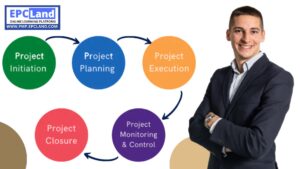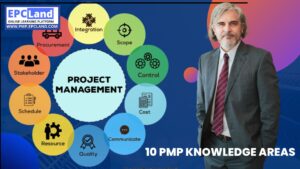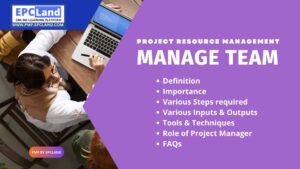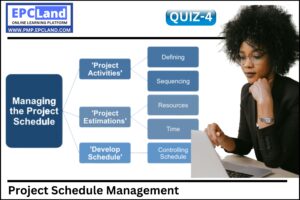Table of Contents
ToggleWhat is define activity in Project Schedule Management
In project schedule management, an activity is a specific task or work item that needs to be completed in order to achieve a specific project objective or deliverable. Activities are often broken down into smaller, more manageable tasks and are typically linked to specific project milestones or deliverables.
The definition of an activity includes information such as the task description, duration, dependencies, and resources required to complete the task. Activities are used to create a project schedule, which outlines the sequence of tasks and their expected completion dates, and is used to manage and track progress on a project.
Don’t Miss the 1000+ MCQ questions & hundreds of quizzes on PMP Knowledge Areas and Various important sections.
Attempt Quiz-1 on Define Activities Process

Time's up
What is the purpose of define activity
The purpose of defining activities in project schedule management is to provide a clear and detailed understanding of the tasks that need to be completed in order to achieve the project objectives. Defining activities allows project managers to:
- Break down the project into smaller, more manageable tasks: By breaking down the project into smaller tasks, project managers can better understand the scope of the project and identify any potential issues or challenges.
- Establish a clear project schedule: By defining the activities and their dependencies, project managers can create a project schedule that outlines the sequence of tasks and their expected completion dates.
- Assign resources: By understanding the resources required to complete each task, project managers can assign the appropriate resources to each activity, ensuring that the project has the necessary resources to be completed on time.
- Track progress: By defining activities, project managers can establish a clear baseline for project progress. By monitoring the status of each activity, project managers can identify any delays or issues early on and take corrective action if necessary.
- Communicate effectively: By defining activities, project managers can communicate the project plan and progress effectively to project stakeholders.
What is role of Project Manager in define activity Process
The role of a project manager in the define activity process is to lead the effort in identifying and defining the specific tasks and work items that need to be completed in order to achieve the project objectives. This includes:
- Identifying the project objectives and deliverables: The project manager will work with the project team and stakeholders to clearly define the project objectives and the deliverables that need to be produced.
- Breaking down the project into smaller tasks: The project manager will lead the effort to break down the project into smaller, more manageable tasks. These tasks will become the activities that will be scheduled and tracked throughout the project.
- Establishing activity dependencies: The project manager will work with the project team to identify the dependencies between activities. This includes identifying the order in which tasks must be completed and any constraints that may affect the scheduling of the project.
- Assigning resources: The project manager will work with the project team to identify the resources (e.g., personnel, equipment, materials) required to complete each activity.
- Creating the project schedule: The project manager will use the defined activities and their dependencies to create a project schedule that outlines the sequence of tasks and their expected completion dates.
- Communicating the project plan: The project manager will communicate the project plan and schedule to project stakeholders, including the project team, sponsors, and other key stakeholders.
- Tracking progress: The project manager will use the defined activities and schedule to track progress on the project, identify issues or delays, and take corrective action if necessary.
Tools & techniques for define activity Process
There are several tools and techniques that project managers can use to assist in the define activity process, including:
- Work breakdown structure (WBS): A WBS is a hierarchical breakdown of the project into smaller, more manageable components. It is a visual representation of the project that helps to define the activities and their relationships to each other.
- Flowcharting: Flowcharting is a technique that uses diagrams to represent the flow of activities in a project. This can help project managers to identify dependencies between activities and understand the sequence of tasks that need to be completed.
- Expert judgment: Project managers may seek the input and advice of subject matter experts in order to define activities and identify potential risks or challenges.
- Historical information: Project managers may use information from previous similar projects to help define activities and identify best practices.
- Meetings: Project managers may use meetings to gather input and feedback from project stakeholders and team members in order to define activities and identify dependencies.
- Project Management Software : Project management software like Asana, Trello, Basecamp, etc can be helpful for project managers to create and manage project schedule, track progress and communicate with team members and stakeholders.
- Mind Mapping: Mind mapping is a visual tool that helps to organize and structure information by creating a “map” of related ideas and concepts. This can be useful for project managers in defining activities and identifying dependencies.
Inputs for Define Activity Process
- Project charter: This document outlines the project objectives and deliverables and serves as the foundation for the project plan.
- Scope statement: This document defines the boundaries of the project and serves as the basis for defining the activities.
- Requirements: This includes all the requirements that need to be met by the project, such as performance, quality, and design requirements.
- Resource availability: This includes information about the personnel, equipment, and materials that will be available to the project.
- Historical information: Information from previous similar projects can be used to inform the current project.
- Expert judgment: This includes the input and advice of subject matter experts who can provide insight into potential risks and challenges.
Outputs for define activity process
- Work breakdown structure (WBS): This hierarchical breakdown of the project into smaller, more manageable components serves as the foundation for the project schedule.
- Activity list: This is a comprehensive list of all the activities that need to be completed in order to achieve the project objectives.
- Activity attributes: This includes information about each activity, such as the task description, duration, dependencies, and resources required.
- Milestone list: This is a list of key milestones that need to be achieved in order to complete the project.
- Project schedule: This is a detailed plan that outlines the sequence of activities and their expected completion dates.
- Resource assignments: This includes the assignment of personnel, equipment, and materials to the various activities.
- Baseline plan: This serves as a baseline for tracking progress and measuring performance throughout the project.
Why define activity Process is important in Project Management
The define activity process is important in project management because it helps to:
- Establish a clear understanding of the project objectives and deliverables: By clearly defining the project objectives and deliverables, the project manager and the project team have a clear understanding of what needs to be accomplished and can focus their efforts on achieving those goals.
- Break the project into smaller, more manageable tasks: By breaking the project into smaller tasks, the project manager and the project team can focus on completing specific tasks and can better track progress towards the project objectives.
- Establish a project schedule: By defining the activities and their dependencies, the project manager can create a detailed project schedule that outlines the sequence of tasks and their expected completion dates. This allows the project manager to track progress and identify potential delays.
- Assign resources: By identifying the resources required to complete each activity, the project manager can ensure that the necessary personnel, equipment, and materials are available when they are needed.
- Communicate the project plan: By clearly defining the activities and their dependencies, the project manager can communicate the project plan and schedule to project stakeholders, including the project team, sponsors, and other key stakeholders.
- Identify and manage risks: By identifying the activities and their dependencies, the project manager can identify potential risks and take steps to mitigate them before they become issues.
- Track progress: By defining the activities and their dependencies, the project manager can track progress and measure performance throughout the project. This allows the project manager to identify issues or delays early on and take corrective action if necessary.
In summary, the define activity process is an important step in project management as it lays the foundation for the project schedule and plan, and provides the information needed to monitor and control the project.
Attempt Quiz-2 on Define Activities Process

Time's up
FAQs on "Define Activity" in Project Schedule Management
What is an activity in project management? An activity in project management refers to a specific task or set of tasks that must be completed in order to achieve a project goal.
What are the characteristics of an activity in project management? An activity in project management typically has a specific duration, resources required, dependencies, and deliverables.
How are activities defined in a project schedule? Activities in a project schedule are defined through a process called activity definition, which involves breaking down a project into smaller, manageable tasks.
What is the importance of defining activities in project management? Defining activities in project management is important as it helps to provide a clear understanding of what needs to be done, who is responsible for doing it, and when it needs to be done. This information is crucial for effectively managing a project and ensuring its success.
How do you ensure that activities are properly defined in a project schedule? Ensuring that activities are properly defined in a project schedule requires a thorough understanding of the project goals and objectives, as well as close collaboration between project team members and stakeholders. It may also require the use of project management tools and techniques to accurately define and track activities.




















